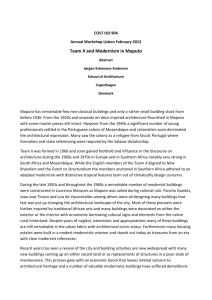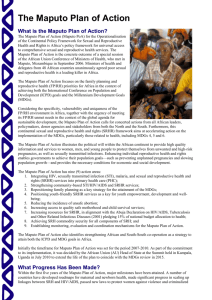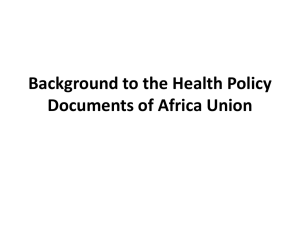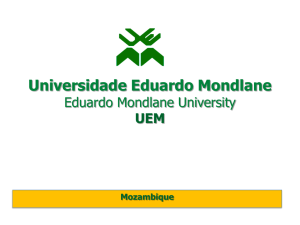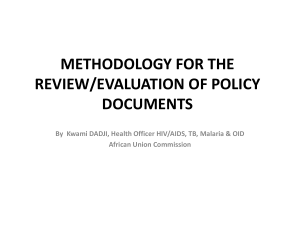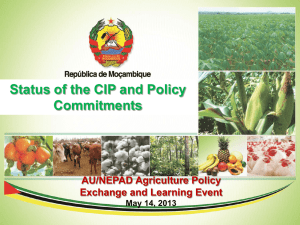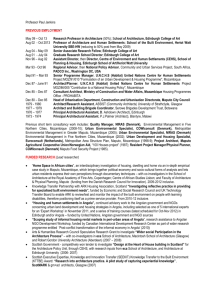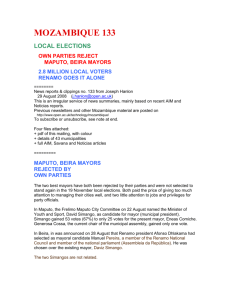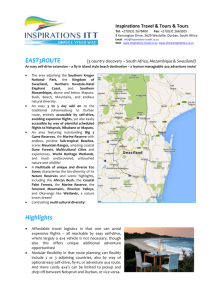Maputo-Port-Development&Citrus-Planning-Workshop-2011
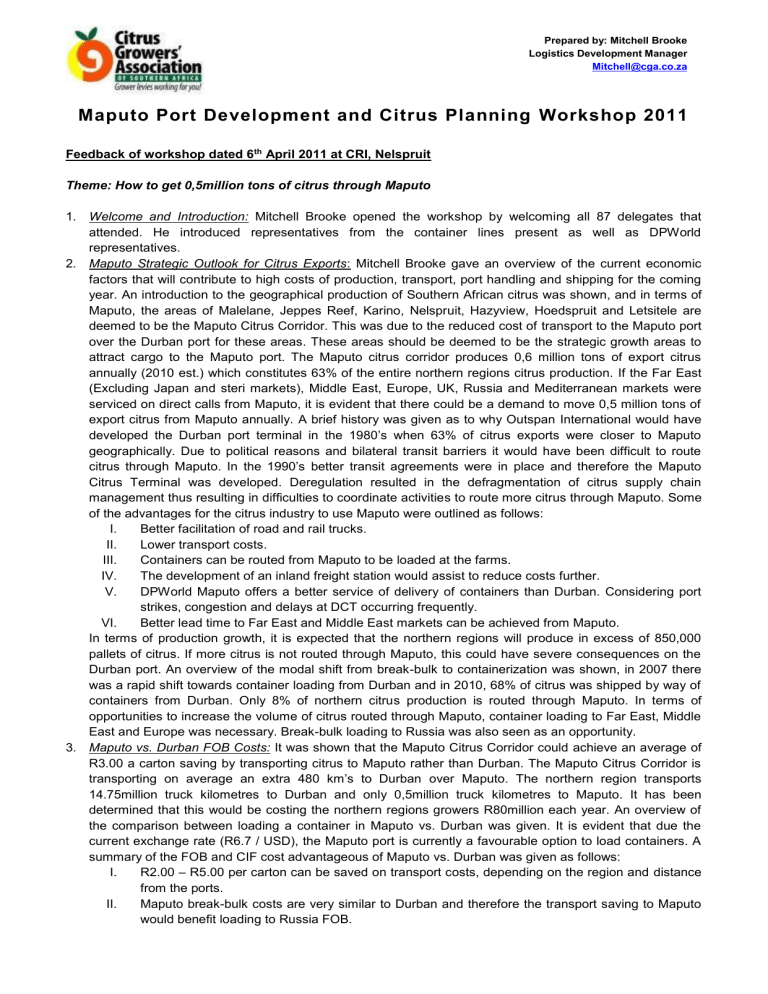
Prepared by: Mitchell Brooke
Logistics Development Manager
Mitchell@cga.co.za
Maputo Port Development and Citrus Planning Workshop 2011
Feedback of workshop dated 6 th April 2011 at CRI, Nelspruit
Theme: How to get 0,5million tons of citrus through Maputo
1. Welcome and Introduction: Mitchell Brooke opened the workshop by welcoming all 87 delegates that attended. He introduced representatives from the container lines present as well as DPWorld representatives.
2. Maputo Strategic Outlook for Citrus Exports : Mitchell Brooke gave an overview of the current economic factors that will contribute to high costs of production, transport, port handling and shipping for the coming year. An introduction to the geographical production of Southern African citrus was shown, and in terms of
Maputo, the areas of Malelane, Jeppes Reef, Karino, Nelspruit, Hazyview, Hoedspruit and Letsitele are deemed to be the Maputo Citrus Corridor. This was due to the reduced cost of transport to the Maputo port over the Durban port for these areas. These areas should be deemed to be the strategic growth areas to attract cargo to the Maputo port. The Maputo citrus corridor produces 0,6 million tons of export citrus annually (2010 est.) which constitutes 63% of the entire northern regions citrus production. If the Far East
(Excluding Japan and steri markets), Middle East, Europe, UK, Russia and Mediterranean markets were serviced on direct calls from Maputo, it is evident that there could be a demand to move 0,5 million tons of export citrus from Maputo annually. A brief history was given as to why Outspan International would have developed the Durban port terminal in the 1980’s when 63% of citrus exports were closer to Maputo geographically. Due to political reasons and bilateral transit barriers it would have been difficult to route citrus through Maputo. In the 1990’s better transit agreements were in place and therefore the Maputo
Citrus Terminal was developed. Deregulation resulted in the defragmentation of citrus supply chain management thus resulting in difficulties to coordinate activities to route more citrus through Maputo. Some of the advantages for the citrus industry to use Maputo were outlined as follows:
I. Better facilitation of road and rail trucks.
II. Lower transport costs.
III. Containers can be routed from Maputo to be loaded at the farms.
IV. The development of an inland freight station would assist to reduce costs further.
V. DPWorld Maputo offers a better service of delivery of containers than Durban. Considering port strikes, congestion and delays at DCT occurring frequently.
VI. Better lead time to Far East and Middle East markets can be achieved from Maputo.
In terms of production growth, it is expected that the northern regions will produce in excess of 850,000 pallets of citrus. If more citrus is not routed through Maputo, this could have severe consequences on the
Durban port. An overview of the modal shift from break-bulk to containerization was shown, in 2007 there was a rapid shift towards container loading from Durban and in 2010, 68% of citrus was shipped by way of containers from Durban. Only 8% of northern citrus production is routed through Maputo. In terms of opportunities to increase the volume of citrus routed through Maputo, container loading to Far East, Middle
East and Europe was necessary. Break-bulk loading to Russia was also seen as an opportunity.
3. Maputo vs. Durban FOB Costs: It was shown that the Maputo Citrus Corridor could achieve an average of
R3.00 a carton saving by transporting citrus to Maputo rather than Durban. The Maputo Citrus Corridor is transporting on average an extra 480 km’s to Durban over Maputo. The northern region transports
14.75million truck kilometres to Durban and only 0,5million truck kilometres to Maputo. It has been determined that this would be costing the northern regions growers R80million each year. An overview of the comparison between loading a container in Maputo vs. Durban was given. It is evident that due the current exchange rate (R6.7 / USD), the Maputo port is currently a favourable option to load containers. A summary of the FOB and CIF cost advantageous of Maputo vs. Durban was given as follows:
I. R2.00 – R5.00 per carton can be saved on transport costs, depending on the region and distance from the ports.
II. Maputo break-bulk costs are very similar to Durban and therefore the transport saving to Maputo would benefit loading to Russia FOB.
III. All areas within a 200km (North Swaziland, Malelane, Karino and Nelspruit) radius of Maputo are guaranteed to achieve a better CIF deal to Europe break-bulk over loading containers through
Durban (USD500 container rebate used in the equation).
IV. Container costs in Maputo are comparable to Durban.
V. By loading ambient at a freight station in Nelspruit or ambient in Maputo, there is a potential to save >R4.00 per carton against loading containers in Durban.
VI. The biggest savings appears to come from positioning containers in the Maputo port and trucking them to packhouses to load citrus and delivering the containers to the DPWorld stacks. It is estimated this could save between R3.00 – R5.00 per carton for this region.
The strategic Outlook of Maputo was described as:
I. More efficient and cost effective transport to Maputo.
II. Upgraded facility required in Maputo if demand increases to beyond 100,000 pallets annually.
III. Facility development either in port, out of port or in Komatipoort.
IV. Better customs document control – specifically the transhipped phyto through Mozambique. (See requirements for Russian shipments)
V. Commitment from DAFF and PPECB to supply resources to manage the demand.
VI. Europe and Russia to be serviced weekly by the break-bulk options.
VII. Container lines servicing Maputo on direct calls to key citrus markets i.e. Middle East.
VIII. Reefer technical backup and adequate pre-trip facilities in Maputo.
4. Lebombo Ressano-Garcia Border Post Operations & Developments: Eddie Ferreira from Delta Metreta gave an overview of the process that should be followed to ensure that road and rail trucks do not experience delays at the border post. He encouraged all transport operators and citrus production points to utilize more established clearing agents rather than allowing transport operators to manage the clearing process. He assured that by using a reputable agent and by following a recommended process that trucks would enter through the border within a 30min time frame. His recommendation was endorsed by other border clearing agents present. He also added that the same principle should apply to containers loaded with citrus in South Africa that would be transiting through Maputo. He added that Delta clearing is willing to conduct a briefing session with packhouse personnel to inform them of how to prepare documentation prior to a truck arriving at the border post. Barbara Mommen gave an overview of the freight bypass road that was recently concluded to allow the free passage of freight trucks through the border post.
5. Nelspruit Container Freight Station: Jan Bekker gave an overview of the container loading facility that will see empty containers being railed from Maputo to Nelspruit to be packed. Containers can either be packed at the Nelspruit facility or the containers can be road trucked to packhouses to be packed and taken back to the Nelspruit facility. The containers will then be routed to DPWorld Maputo. Indications of the costs were shown which included a full turn quay solution from packhouse to loading on vessel. There were concerns regarding containers being overweight resulting in fines at weighbridges; this was seen as an obstacle to load containers at packhouses for Maputo. It was noted that Grapefruit should not be a problem but Valencia's could well be overweight. Discussions continued around the weight of containers fully loaded with citrus against the maximum permissible weight according to regulations. There was mention made that there are trailers available that should allow the transporting of fully loaded Reefer containers. Mitchell
Brooke indicated that he would investigate this matter further and provide feedback.
6. Maputo Citrus Phyto Inspections & Inspection Procedures: Mike Holtshausen from DAFF presented the process to be followed for inspections to be conducted in the port of Maputo. He reiterated that written notification of inspections in Maputo must be given prior to inspections being conducted. He also noted the requirement for the re-issuing of Phytos for cargo transiting Maputo for the Russian market. Connie
Papageorge enquired regarding inspections for the Iran market from Maputo; Mike Holtshausen indicated that it should be possible. Mitchell Brooke noted that FPT had already initiated the ground work for this process. (More information on this topic can be found on the CGA website)
7. MPT Operational Feedback: Paulo Franco requested that the industry send through forecasts in order to plan utilization of the terminal more effectively. He also requested that packhouses and transporters book trucks with the terminal to ensure that adequate staff are in place to manage an influx of trucks if need be.
He indicated that Matola Cargo Terminal will be offering additional ambient space should the MPT citrus terminal become congested in 2011. Filipe Franco added that the Matola Cargo Terminal had maintained their cooling plants and that if there is a requirement, the plant can be in operation. He noted that MCT could not offer cooling for 2011 but can be offered for 2012 should there be a firm indication. Mitchell
Brooke gave an indication that the MPT concession may not be available for renewal once the current concession expires in 2012 – based on MPDC plans to develop the current berths.
8. GoReefers Operational Feedback: Deirdre de Klerk gave a brief explanation of the GoReefers group and the service offered by GoReefers. She indicated that clients can use the Maputo service and are not obligated to use GoReefers for South African services. The Maputo service offering is an exclusive service and any of the specific categories of services can be utilized as well as full supply chain management from farm to market including an not limited to Transportation – Border Clearing – Documentation processing
(customs / phyto) – Cold Storage at MPT – Ambient storage at GoReefers facility – DAFF inspection facilitation – PPECB inspection facilitation – cargo monitoring – container preparation, pre-trip and PPECB
Inspection - container packing – container cross-haul. Deidre emphasised the point that exporting citrus from Maputo is vastly different to exporting from South African ports. She mentioned that GoReefers had 7 seasons worth of experience in the port and has the ability to ensure shipments of citrus are streamlined.
Thorough planning was necessary to ensure the success of exports from Maputo and in particular when storing and loading from ambient conditions. She gave an overview of the GoReefers ambient loading facility in Maputo (8.4km from the port) that is accessible by road and rail. The facility can store up to 1,000 pallets with more capacity if required. There is also an area that can be used for DAFF inspections if required as well as the ability to clean and pre-trip Reefer containers. She also firmed that GoReefers had a relationship with Baltic Shipping and that it was confirmed that vessels will call to Maputo on inducement.
She mentioned that citrus can be shipped to Russia at ambient with a maximum temperature not exceeding
15 °C. Mitchell Brooke advised that an agreement was reached with PPECB to allow ambient citrus to be loaded to Russia from Maputo without precooling. A T13 dispensation would be considered by PPECB with agreement from all shippers loading on a specific vessel.
9. Maputo Break-bulk Developments: Mitchell Brooke gave an overview of the current break-bulk service offerings through Maputo.
I. Northern Europe and UK are serviced by Seatrade and NYKCool on a vessel sharing arrangement termed VSA. This service calls Maputo on a 7 day basis.
II. Seatrade service the Southern Europe and MED ports on a 10 day rotation.
A proposal to increase the on-deck container service offered by Seatrade and NYKCool was discussed whereby empty containers could be discharged from these vessels and transported to packhouses to be packed and then re-load on-deck. Connie Papageorge indicated that there is limitation for this service due to the need for other ports of loading to gain access to hatches for loading. It was also mentioned that there is a requirement in terms of the DPWorld concession for any vessel discharging and loading more than 25 containers to utilize the DPWorld Maputo berth.
III. It was mentioned that Seatrade have reached an agreement with certain buyers in Russia to transport citrus to Russia. This service was offered during 2010 and would in all probability be expanded for 2011.
IV. An agreement has also been reached with Baltic Shipping to supply a service to Maputo to Russia based on Inducement. This development was still to be finalized on how the coordination activity was to be conducted.
10. Maputo Containerized Options & Developments: Jan Bekker gave an overview of the current container line services from Maputo relevant to Reefer trades.
I. Mol: Weekly named day service to Singapore (MZX)
II. Maersk / Safmarine: Weekly named day service to Tanjung Pelepas (M-Express).
III. CMA CGM: 11 Day service to Port Kelang (MOZEX)
IV. PIL: 10 Day service to Singapore
V. MSC: 10 Day feeder service to Durban
(Containers can be transhipped from these ports to Far East, Middle East, Asia and Mediterranean ports)
There was debate from container line representatives regarding services that could be established from
Maputo for the citrus industry. General feedback was that Middle East should be the first option considered on direct calls to Maputo. Arnaud Thibault mentioned that in most cases the contracts for shipping space to Middle East lies with the buyers and that it may be difficult to implement on that basis.
I. Richard Purchase from MOL suggested the MZX service change port rotation from Durban –
Maputo to Maputo – Durban. This would allow containers packed in Maputo to be transited via
Durban and connect with core services on a weekly basis. (See below example)
II. Arnaud Thibault from CGA CGM indicated that there were two options that could be considered by adding a Maputo port call on the SWAHILI service (East Africa – Middle East) or the MIDAS service (West Africa – Middle East).
There was further discussion around indications for cargo placement in Maputo; the response was that the fruit is closer to the port that Durban and that service offered from Maputo to key markets will be used by the industry. Shipping lines representatives indicated that they would require indications from shippers regarding the volume to be shipped from Maputo to motivate a direct service from the port. There was a brief discussion regarding the dredging surcharge to be added to containers serviced from Maputo, it was indicated that this would be an additional USD50.00 per FEU. Jan Bekker suggested to shippers to keep communications regarding developments in Maputo with the shipping line representatives based in Maputo rather than only discuss developments with the South African offices. (Recommendation for shippers to communicate with lines offices in Maputo as well as South Africa in terms of developments in the Maputo port)
11. DPWorld Development of the MICD: Frans Visser gave an overview of the MICD development due to commence this year. This development will see the staging of empty containers at the ICD. Reefer pre-trip and washing facilities will be provided as well as some 90 Reefer plug in points. The development is due to be implemented on two phases of which the first phase is due for completion by September 2011. It was mentioned that empty Reefer containers will be routed from DPWorld Maputo to MICD for preparation and are to be collected from MICD by shippers. Full Reefer containers will be delivered to DPWorld Maputo. A rail siding is available to transport containers from MICD inland and full’s to be delivered to DPWorld
Maputo. It was indicated that it was not envisaged that containers would receive additional costs with the development of this facility.
12. Mitchell Brooke closed the meeting by encouraging all role players to continue with the momentum to achieve the target of increasing citrus volume through Maputo. It was also stressed to container shipping lines to take a bold step by servicing Maputo on direct calls to Middle East.
The various presentations and attendance list can be found on the Logistics / Maputo section on the CGA website www.cga.co.za
The Basis of Ambient loading of Containers:
Why is there such a drive by industry to consider ambient loading of citrus products? The current economic climate suggests that the cost of exporting citrus will rise in a greater proportion than the price received in the markets. By loading citrus from ambient conditions can reduce the cost of exporting significantly. The most significant saving comes from reducing the pre-cooling and storage costs at the harbour, it has been determined that a saving of around R250 per pallet (R3.00 per carton) can be made by loading from ambient. A further saving comes from packing containers at the farm and railing or trucking the container directly to the port container terminal. With this practice all handling and storage costs are omitted as well as omitting the port container cross-haul cost (transporting of container from an empty depot to the facility to be packed and transporting to port container terminal). Studies were done by Malcolm Dodd (FPEF) which has indicated that ambient loading of citrus into an Integral Reefer Container can be successfully completed. The shipping temperatures on the trials conducted were achieved between 4 – 7days after the containers were coupled to a constant power source. However PPECB have outlined the conditions for this practice which has been stipulated in the HP01 document.
There are some options available to the northern region as far as ambient loading through Maputo is concerned. If we consider that transport costs to Maputo are lower than to Durban and with the reduced precooling and storage costs, significant savings can be achieved:
1. The greatest saving should be where empty containers can be washed and pre-tripped in Maputo and road trucked to packhouses to be packed and delivered back to the port. If the overweight issues can be resolved this should be an advantageous development area. This option can be limited in the ability for a single packhouse to load a significant portion of citrus to a receiver complying with the specific fruit spec. Therefore there will; in most cases, be a need to consolidate citrus at a central point where multiple suppliers’ fruit can be used to pack containers to meet the specific fruit spec.
2. The development of the Nelspruit Freight Station can be used to truck citrus to this facility and pack containers to be railed to Maputo. The other more limited option would be for the containers to be railed to Nelspruit and then road trucked from Nelspruit to packhouses to be packed an redelivered to
Nelspruit where the containers can then be railed to Maputo.
3. The other option is to truck citrus to one of the available ambient facilities located in Maputo. Citrus can then be packed into containers and road trucked to the port.
There are precautions for the loading of citrus from ambient conditions:
1. Thorough planning is required to ensure that all the steps in the process are adhered to limiting the duration the fruit will remain in ambient.
2. The guarantee of availability of empty containers in the Maputo port prior to sending fruit.
3. Accurate timing of packing of containers to ensure minimal terminal plug-in charges are incurred.
An Emphasis on Planning:
1. Exporters and Agents are strongly advised to plan thoroughly when it comes to directing citrus through the port of Maputo. Due to capacity constraints and limited available cold slots (2,500 pallets), the need to forward plan is essential. It is essential that volume forecasts are sent through the various loading facilities to ensure that sufficient capacity can be allocated thus reducing the chance of port block-outs situations to occur. The requirement for citrus loaded to Russia not to exceed a pulp temperature of
15°C mean that Russia fruit will most likely be required to be directed through MPT. There is a provision made by PPECB for a dispensation on this requirement which would allow citrus to be routed from an ambient facility direct to ship.
(The PPECB HP01 document pertaining to loading requirements can be found on the PPECB website www.ppecb.com
)
2. There is a limitation on the percentage of warm fruit that can be loaded on the Europe vessels (52% from all ports), thus a requirement for certain amount of citrus to be pre-cooled in Maputo.
3. In order to ensure that farm trucks are off-loaded in the quickest time, trucks should be pre-cleared at the border and pre-booked with the facilities in Maputo.
Development Areas:
1. Position on Baltic Shipping vessels calling Maputo will be firmed with Baltic Shipping and arrangement communicated.
2. CGA to administer DAFF inspections in Maputo, communication to be distributed.
3. Research weight restrictions of containers loaded with citrus moved by road.
4. Communicate with shipping lines in terms of positioning / aligning vessels suitable for citrus exports ex
Maputo.
5. Ensure PPECB are adequately resourced in Maputo.
Comparative container shipment of citrus from Letsitele to Northern Europe via Maputo
This example is based on MOL lines changing port rotation on the MZX service via Maputo from Maputo –
Durban – Singapore bound. (Currently Durban – Maputo – Singapore bound). This would also reduce the shipping time from Durban – Singapore. This example suggests that it would be possible to pack containers ex
Maputo and tranship via Durban on the SAECS core service. A full week’s citrus pack would be able to be transported to Maputo and be transhipped from Durban meeting the same container ship as if the fruit was directed to Durban. Both the MZX and SAECS Core services appear to be named day services thus allowing better integrity of the transhipment between the two ports. According to the MOL schedules, the MZX service could depart Maputo on a Wednesday and discharge containers in Durban on a Friday meeting the SAECS
Core service loading a Saturday/Sunday in Durban. The available example should be considered by MOL where there is a strong possibility that this development could favour the citrus industry at the same time creating a demand on the SAECS Core service
